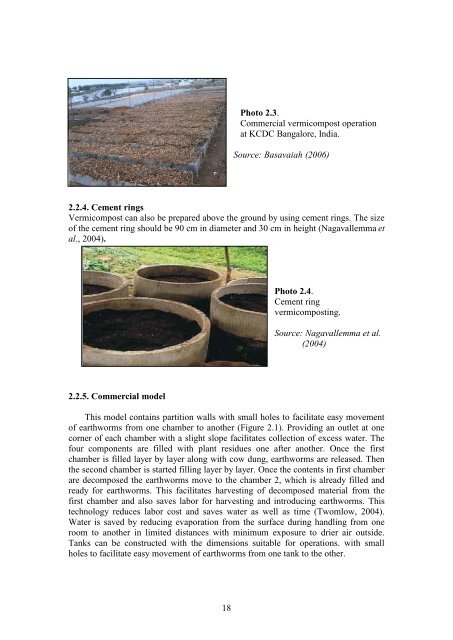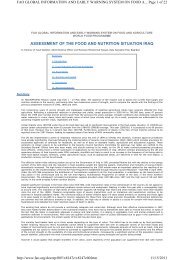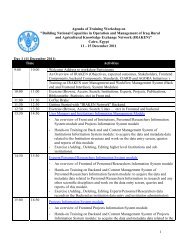Vermiculture in Egypt: - FAO - Regional Office for the Near East and
Vermiculture in Egypt: - FAO - Regional Office for the Near East and
Vermiculture in Egypt: - FAO - Regional Office for the Near East and
You also want an ePaper? Increase the reach of your titles
YUMPU automatically turns print PDFs into web optimized ePapers that Google loves.
18<br />
Photo 2.3.<br />
Commercial vermicompost operation<br />
at KCDC Bangalore, India.<br />
Source: Basavaiah (2006)<br />
2.2.4. Cement r<strong>in</strong>gs<br />
Vermicompost can also be prepared above <strong>the</strong> ground by us<strong>in</strong>g cement r<strong>in</strong>gs. The size<br />
of <strong>the</strong> cement r<strong>in</strong>g should be 90 cm <strong>in</strong> diameter <strong>and</strong> 30 cm <strong>in</strong> height (Nagavallemma et<br />
al., 2004).<br />
2.2.5. Commercial model<br />
Photo 2.4.<br />
Cement r<strong>in</strong>g<br />
vermicompost<strong>in</strong>g.<br />
Source: Nagavallemma et al.<br />
(2004)<br />
This model conta<strong>in</strong>s partition walls with small holes to facilitate easy movement<br />
of earthworms from one chamber to ano<strong>the</strong>r (Figure 2.1). Provid<strong>in</strong>g an outlet at one<br />
corner of each chamber with a slight slope facilitates collection of excess water. The<br />
four components are filled with plant residues one after ano<strong>the</strong>r. Once <strong>the</strong> first<br />
chamber is filled layer by layer along with cow dung, earthworms are released. Then<br />
<strong>the</strong> second chamber is started fill<strong>in</strong>g layer by layer. Once <strong>the</strong> contents <strong>in</strong> first chamber<br />
are decomposed <strong>the</strong> earthworms move to <strong>the</strong> chamber 2, which is already filled <strong>and</strong><br />
ready <strong>for</strong> earthworms. This facilitates harvest<strong>in</strong>g of decomposed material from <strong>the</strong><br />
first chamber <strong>and</strong> also saves labor <strong>for</strong> harvest<strong>in</strong>g <strong>and</strong> <strong>in</strong>troduc<strong>in</strong>g earthworms. This<br />
technology reduces labor cost <strong>and</strong> saves water as well as time (Twomlow, 2004).<br />
Water is saved by reduc<strong>in</strong>g evaporation from <strong>the</strong> surface dur<strong>in</strong>g h<strong>and</strong>l<strong>in</strong>g from one<br />
room to ano<strong>the</strong>r <strong>in</strong> limited distances with m<strong>in</strong>imum exposure to drier air outside.<br />
Tanks can be constructed with <strong>the</strong> dimensions suitable <strong>for</strong> operations. with small<br />
holes to facilitate easy movement of earthworms from one tank to <strong>the</strong> o<strong>the</strong>r.





